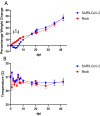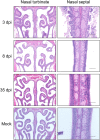Recovery of anosmia in hamsters infected with SARS-CoV-2 is correlated with repair of the olfactory epithelium
- PMID: 35022504
- PMCID: PMC8755745
- DOI: 10.1038/s41598-021-04622-9
Recovery of anosmia in hamsters infected with SARS-CoV-2 is correlated with repair of the olfactory epithelium
Abstract
Severe acute respiratory syndrome coronavirus-2 (SARS-CoV-2) is responsible for a pandemic affecting billions of people worldwide. Apart from the extreme global economic impact, the pandemic will likely have a lasting impact through long-term sequelae not yet fully understood. Fully understanding the mechanisms driving the various symptoms and sequelae of SARS-CoV-2 infection will allow for the eventual development of therapeutics to prevent or treat such life-altering symptoms. In this study, we developed a behavioral test of anosmia in SARS-CoV-2-infected hamsters. We find a moderately strong correlation between the level of anosmia and the score of histological damage within the olfactory epithelium. We also find a moderately strong correlation between the level of anosmia and the thickness of the olfactory epithelium, previously demonstrated to be severely damaged upon infection. Thus, this food-searching behavioral test can act as a simple and effective screening method in a hamster model for various therapeutics for SARS-CoV-2-related anosmia.
© 2022. The Author(s).
Conflict of interest statement
The authors declare no competing interests.
Figures






Similar articles
-
Regeneration Profiles of Olfactory Epithelium after SARS-CoV-2 Infection in Golden Syrian Hamsters.ACS Chem Neurosci. 2021 Feb 17;12(4):589-595. doi: 10.1021/acschemneuro.0c00649. Epub 2021 Feb 1. ACS Chem Neurosci. 2021. PMID: 33522795 Free PMC article.
-
COVID-19-related anosmia is associated with viral persistence and inflammation in human olfactory epithelium and brain infection in hamsters.Sci Transl Med. 2021 Jun 2;13(596):eabf8396. doi: 10.1126/scitranslmed.abf8396. Epub 2021 May 3. Sci Transl Med. 2021. PMID: 33941622 Free PMC article.
-
Olfactory Cleft Measurements and COVID-19-Related Anosmia.Otolaryngol Head Neck Surg. 2021 Jun;164(6):1337-1344. doi: 10.1177/0194599820965920. Epub 2020 Oct 13. Otolaryngol Head Neck Surg. 2021. PMID: 33045908 Free PMC article.
-
The Molecular Basis of Olfactory Dysfunction in COVID-19 and Long COVID.Lifestyle Genom. 2024;17(1):42-56. doi: 10.1159/000539292. Epub 2024 May 15. Lifestyle Genom. 2024. PMID: 38749402 Review.
-
COVID-19 Anosmia: High Prevalence, Plural Neuropathogenic Mechanisms, and Scarce Neurotropism of SARS-CoV-2?Viruses. 2021 Nov 4;13(11):2225. doi: 10.3390/v13112225. Viruses. 2021. PMID: 34835030 Free PMC article. Review.
Cited by
-
Neuroinvasive and neurovirulent potential of SARS-CoV-2 in the acute and post-acute phase of intranasally inoculated ferrets.PLoS One. 2025 Apr 7;20(4):e0311449. doi: 10.1371/journal.pone.0311449. eCollection 2025. PLoS One. 2025. PMID: 40193353 Free PMC article.
-
Olfactory dysfunction in COVID-19: new insights into the underlying mechanisms.Trends Neurosci. 2023 Jan;46(1):75-90. doi: 10.1016/j.tins.2022.11.003. Epub 2022 Nov 16. Trends Neurosci. 2023. PMID: 36470705 Free PMC article. Review.
-
The Olfactory System: Basic Anatomy and Physiology for General Otorhinolaryngologists.Clin Exp Otorhinolaryngol. 2023 Nov;16(4):308-316. doi: 10.21053/ceo.2023.00185. Epub 2023 Sep 4. Clin Exp Otorhinolaryngol. 2023. PMID: 37669740 Free PMC article. Review.
-
Optimization of a panel of behavioral tests for use in containment using a golden Syrian hamster model.J Virol Methods. 2025 Jun;335:115132. doi: 10.1016/j.jviromet.2025.115132. Epub 2025 Mar 3. J Virol Methods. 2025. PMID: 40043811 Free PMC article.
-
The SARS-CoV-2 envelope PDZ binding motif acts as a virulence factor disrupting host's epithelial cell-cell junctions.Cell Mol Biol Lett. 2025 Jul 11;30(1):80. doi: 10.1186/s11658-025-00758-y. Cell Mol Biol Lett. 2025. PMID: 40646464 Free PMC article.
References
-
- Engineering, T.C.f.S.S.a. COVID-19 Dashboard. 2021; Available from: https://coronavirus.jhu.edu/map.html.
Publication types
MeSH terms
Grants and funding
LinkOut - more resources
Full Text Sources
Medical
Miscellaneous

